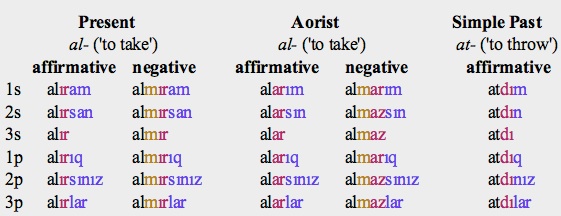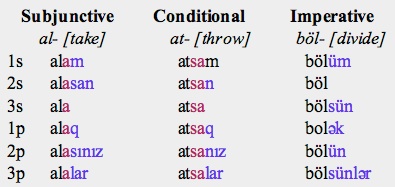An insatiable appetite for ancient and modern tongues


Alternative Names: Azerbaijani, Azeri.
Classification: Altaic?, Turkic, Southwestern (Oghuz) branch, Western group. Azerbaijanian is a member of the Turkic family. The external classification of Turkic is disputed. Many consider it one of the three divisions of the Altaic phylum (the other two are Tungusic and Mongolic). However, the parallelisms between Turkic, Mongolic and Tungusic are too few, according to others, to support the unity of Altaic. Azerbaijanian belongs to the western group of the Oghuz branch along with Turkish and Gagauz.
Overview. Azerbaijanian is the descendant of the language of the Oghuz tribes that arrived in the area of Azerbaijan during the 10th-11th centuries, after the collapse of their empire in 744 CE. They had little contact with the Turks of Turkey, and from the end of the 14th century there is evidence that Azerbaijanian had diverged from Anatolian Turkish. It is still quite closely related to Turkish though it has been strongly influenced by Persian. For several centuries and until the early 20th century, it was employed as a lingua franca in the Transcaucasic region, eastern Turkey and northwestern Iran.
Distribution. The majority of Azerbaijanian speakers live in the independent Republic of Azerbaijan and in northwestern Iran (province of Azerbaijan). Others inhabit eastern Turkey, several countries of the Caucasus region (Armenia, Georgia, Russia bordering Azerbaijan), the Middle East (northern Iraq, Syria) and central Asia (Kazakhstan, Uzbekistan, Turkmenistan, Kyrgyzstan).
Speakers. There are around 23,000,000 native speakers of Azerbaijanian distributed in the following countries:
Iran
Azerbaijan
Russia
Iraq
Turkey
Georgia
Armenia
Kazakhstan
Ukraine
Uzbekistan
Turkmenistan
Syria
Kyrgyzstan
13,000,000
7,200,000
650,000
600,000
530,000
380,000
150,000
90,000
45,000
45,000
35,000
30,000
20,000
Status. Azerbaijanian is the official language of the Republic of Azerbaijan where it is spoken by 80% of the population, half of them monolingual. In Iran it has been banned in public for a long time but recently restrictions have eased.
Varieties. Azerbaijanian dialects can be divided into three groups: Northern Azerbaijanian (Republic of Azerbaijan), Southern Azerbaijanian (northwest Iran) and East Anatolian dialects (Turkey). The standard language is based on the dialect of Baku (the capital of the Republic of Azerbaijan).
Phonology
Vowels (9). The symmetry of the Turkic vowel system is broken by the existence of an additional front vowel ə [æ] which is lower than [e]. Standard Azerbaijanian does not have long vowels.

-
The symbols are those current in writing; when they differ from those of the International Phonetic Alphabet the latter are indicated between brackets.
Vowel harmony. It governs the distribution of vowels within a word opposing front versus back vowels, and rounded versus unrounded ones.
In the first syllable of a word all vowels can occur. If it is a front vowel all the subsequent vowels must be also of the front type. If it is a back vowel all the other vowels must be also of the back type. Thus, all the vowels of a word belong to the same class (back or front) and the vowels of suffixes vary according to the class of vowels in the primary stem. However, a number of suffixes are invariable and are not affected by vowel harmony. The vowels e, ö and o don't occur in suffixes.
If the first vowel of a word is rounded then the following high vowels should be also rounded. But if the following vowel is low there is no harmony because of the phonological constraint that low non-initial vowels must be always unrounded.
Consonants (22). The consonantal system is distinguished by pairs of contrastive voiceless and voiced stops, affricates and fricatives. The voiceless stops (p, t, k) are frequently aspirated. [k] and [g] have palatalized forms.

Stress. Azerbaijanian stress is similar to that of Turkish. It has a pitch accent (increase of the tone height) that usually falls on the last syllable of the word. It has also a stress accent (greater loudness) which tends to fall on the first syllable.
Script and Orthography.
Until 1929 Azerbaijanian was written with the Arabic script when it was replaced by a Latin-derived one. In 1939 the latter was phased out, under Russian influence, in favor of the Cyrillic alphabet (North Azerbaijan belonged to the Soviet Union). With the proclamation of the Republic of Azerbaijan in 1991, a new version of the Latin script was finally adopted. It was reformed in 1992 and contains 32 letters. It corresponds perfectly with the 9 vowels and 22 consonants of the sound system (the extra letter represents palatalized g, indicated by j superscript). The equivalent of each letter in the International Phonetic Alphabet is shown between brackets:

Suffixes variants. Due to sound harmony all vowels and some consonants of suffixes change according to the preceding sounds. This is indicated with capital letters as follows:
-
A indicates a low vowel that is realized as ə after a front vowel, or as a [a] after a back vowel.
-
I indicates a high vowel that is realized as i [i] after a front unrounded vowel, as ü [y] after a front rounded vowel, as ı [ɯ] after a back unrounded vowel, or as u after a back rounded vowel.
-
D may be realized as d or t.
Morphology
Azerbaijanian is an agglutinative language adding different suffixes to a primary stem to mark a number of grammatical functions. Each morpheme expresses only one of them and is clearly identifiable. The only process that depends on prefixation is the formation of intensive adjectives and adverbs. The order of suffixes is rigidly established, derivational suffixes preceding inflectional ones. Nominal and verbal suffixes belong to different classes and they are not interchangeable.
-
Nominal. Nouns are marked by suffixes for number, possession and case (in that order).
-
•gender: Azerbaijanian, like all Turkic languages, has no grammatical gender.
-
•number: singular and plural. The singular is unmarked and the plural is marked with the suffix lar/lər in nouns, pronouns, 3rd person possessive suffixes and finite verbs e.g. at ('horse'), atlar ('horses').
-
•possession: Azerbaijanian has six possessive markers, one for each person and number, which are identical to those of Turkish. The possessive suffix is added to both, pronoun and noun e.g. sənin kitabın ('your book').

-
•case: nominative, accusative, genitive, dative, locative, ablative.
-
Other cases, like instrumental, equative and terminal, are not acknowledged by everybody.
-
The nominative is unmarked; the other cases are marked by suffixes which are subject to vowel harmony. Thus, suffix markers of the accusative and genitive have 4 possible vowels (front i, ü, back ı, u) while those of dative, locative and ablative have two (front ə, back a). In the locative and ablative the consonant can be d or t. Plurals are formed by adding the suffixes -lar or -lər after the stem and before the case marker.

-
•comparatives and superlatives: superlatives are formed by adding the particles en or lap before an adjective, comparatives are made by adding the particle daha before the adjective or by adding the suffix -rak/-rək to it: böyük ('big'), daha böyük or böyükrəc ('bigger'). If the standard of comparison is in the ablative case, these elements can be omitted.
-
•pronouns: personal, reflexive, possessive, demonstrative, interrogative, indefinite.

-
There are personal pronouns for the first, second and third person, singular and plural which are inflected in all cases like nouns. Siz may be also used as a polite 2nd. singular. They are declined like nouns.
-
There are two demonstrative pronouns: bu is equivalent to 'this' and o to 'that'. They form an oblique stem with -n: bun- and on-. Plural and case suffixes can be added to it.
-
Reflexive pronouns are formed with self (öz) plus possessive suffixes: özüm ('myself'), özümüz ('ourselves'), etc.
-
Interrogative pronouns: kim ('who?'), nə ('what?'), hansı ('which?').
-
Indefinite pronouns are formed with the interrogative pronoun plus isə: kim isə ('whoever'), nə isə ('whatever'). Negative pronouns are formed with heç plus an interrogative pronoun: heç kim ('nobody'), heç nə ('nothing').
-
•articles: Azerbaijanian does not have definite articles but the demonstratives bu and o can be used as such.
-
Verbal. A finite verb form has a verbal stem + tense-aspect or mood marker suffixes + personal marker (pronominal or possessive).
-
•person and number: 1s, 2s, 3s; 1p, 2p, 3p. The 3rd person is usually unmarked (has no personal marker) and its plural is distinguished from the singular by adding the plural marker (lar/lər).
-
•tense-aspect: present, aorist, simple past, imperfect, pluperfect, prospective.
-
The aorist expresses an habitual action in the present though it may also have a future sense.
-
The prospective is equivalent to the future. Counterfactual situations (what has not happened or is not the case) can be expressed by combining idi with the prospective, the optative and the conditional. Negation of an action is marked by adding the suffix ma/mə immediately after the stem.
-
The present marker is -(y)Ir, the aorist marker is -(y)Ar. Both have negative conjugations in which -m- is attached directly to the stem, before the tense marker. The simple past is marked by -DI, the prospective by -(y)AcAK. The imperfect and pluperfect are formed with the aid of the copula particle idi.

-
black: verb stem
-
red: tense/aspect marker
-
blue: personal endings
-
brown: negative marker
-
•mood: indicative, subjunctive (or optative), necessitative, conditional, imperative.
-
The subjunctive, besides its usual role, expresses wishes or possibility (like an optative); its usual marker is -(y)A.

-
The necessitative expresses obligation or need ('must'); it is marked by -mAlI. The conditional is formed with -sA.
-
The imperative has no marker but is has its own personal endings; its 2nd person may take different suffixes to express different degrees of emotion.
-
black:verb stem; red: tense/aspect marker; blue: personal endings.
-
•voice: active, reflexive, passive.
-
•non-finite forms: infinitive, participles and verbal adverbs (converbs).
-
The infinitive or verbal noun is formed by adding the suffix -mAK to the stem e.g. ölmək ('die, dying'), almaq ('take, taking'). It takes plural, case markers and possessive suffixes, and can combine with postpositions.
-
Many converbs are formed with the case forms of participles or verbal nouns; they are employed in adverbial clauses where they frequently introduce a temporal or conditional situation. Some converbs indicate that a subsidiary action precedes the main one, others indicate two simultaneous actions ('when', 'while', 'during').
Syntax
Azerbaijanian has a basic Subject-Object-Verb word order like all Turkic languages which, nevertheless, can be changed to highlight a certain topic. It is head final, modifiers preceding their head. Attributes do not agree in number or case with their heads.
Postpositions, corresponding to English prepositions, but placed after the words they interact with, govern the various cases. The particle ki, imported from Persian, often precedes temporal clauses, clauses referring to a purpose, and relative clauses. The latter can also be constructed by means of participles acting as attributes of nouns.
Lexicon
Azerbaijanian has an important layer of Persian and Arabic words (the latter entered indirectly through Persian). Northern Azerbaijanian has incorporated many Russian technical terms since the 19th century.
Basic Vocabulary
one: bir
two: iki
three: üç
four: dörd
five: beş
six: altı
seven: yeddi
eight: səkkiz
nine: doqquz
ten: on
hundred: yüz
father: ata
mother: ana
brother: qardaş
sister: bacı
son: oğul
daughter: qız
head: baş
face: üz
eye: göz
hand: əl
foot: ayaq
heart: ürək
tongue: dil
Key Literary Works (forthcoming)
-
© 2013 Alejandro Gutman and Beatriz Avanzati
Further Reading
-
-'Azerbaijanian'. C. Schönig. In The Turkic Languages, 248-260. L. Johanson & É. Á. Csató (eds). Routledge (1998).
-
-'Das Aserbaidschanische'. G. Doerfer. In Philologiae Turcicae Fundamenta 1, 280–307. J. Deny et al (eds). Aquis Mattiacis Apud Franciscum Steiner (1959).
-
-Elementary Azerbaijani. K. Öztopçu. Ölmez (1999).
Azerbaijanian

Address comments and questions to: gutman37@yahoo.com
MAIN LANGUAGE FAMILIES
LANGUAGE AREAS
Languages of Ethiopia & Eritrea
LANGUAGES by COUNTRY
LANGUAGE MAPS
-
• America
-
• Asia
-
Countries & Regions
-
-
Families
-
• Europe
-
• Oceania